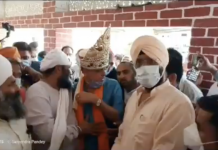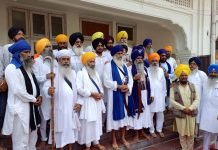


In his famous epic entitled Babarvani, Guru Nanak describes the atrocities committed by the Mogul Emperor Babar, and his forces, as they swept from Persia in the East to the Punjab in the late 15th Century. He describes them as dogs, and brutes, who terrorized the ordinary people of Hindustan, showing no remorse, or compassion for man, woman, or child. Occurrences of inhumanity have scarred post independence India, and though sporadic, the ferocity seems to have reached unprecedented levels. In Punjab alone, reliable estimates are that between the 10 year period after the attack on Sri Harmandir Sahib in 1984, around 100,000 innocent people, mostly, but not exclusively Sikhs, perished at the hands of state sponsored terrorism.
Today, the rulers of Punjab like the despotic, and now mostly deposed Arab dictators, rule like old style monarchs surrounded by sycophants hoping to pick up some crumbs along the way. Tragically, these new rulers claim to be the guardians of the great Sikh Guru’s legacy. Yet, not only do these rulers pay little attention to the basic tenants of the Guru’s philosophy of tolerance, justice, equality, truth, and honesty, they are forming alliances with the Right Wing Hindu fascists. A great new alliance of thieves, and murders, has come together to fight the imminent general election in India. The good news is that the crooks are not a majority; but the bad news is that they seem to have a powerful stranglehold on most levelers of power. So what can be done? How can ordinary people save democracy, social justice, and the rule of law? Not an easy task, but with the emergence of the Aam Aadamy Party (AAP), some rays of hope have emerged.
As always, developments in India tend to have powerful ripple effects amongst the diaspora Indian communities, not least the Sikhs of UK, and Europe. Today, many of the so-called militant groups have abandoned armed struggle, and adopted peaceful, democratic methods. Now Facebook, and Twitter, have replaced the AK47, and RDX, explosives. Sadly, the Indian state has not followed suite, and they retain the use of weapons, from bullets to lathis, as a strategy to suppress the voice of ordinary people.
However, despite the provocation, as we have seen from the effective revolutions in the Arab springs, and now more recently the Ukraine, peaceful protest is ultimately more effective in bringing down dictatorships. That is not to say that once should be passive. To the contrary, what we need today is the right blend of ‘hosh’ and ‘josh’. To put it another way, action without thought is dangerous; thought without action is useless. And so the challenge we face is to translate the phenomenal success Sikhs have achieved in education, profession, and business, into politics.
To date, we Sikhs have been appalling politicians, the reason being that our mentality has yet to escape the village ‘panthcheti’ system. We tend to elect leader ‘pardans’ that have lots of josh, but little hosh, and we have devious back seat drivers – general secretaries – who do all the string pulling, often for their own personal egotistical ends, rather than the needs of the community. To date, sadly, many of our jathebandhis tend to replicate these very same dynamics on a larger scale.
The main problem with such an approach is that politics tends to be diverted from the most important aim, which in the context of Gurdwaras, and panthik affairs, would be to promote Sikh interests at a local, regional, national, and global, levels. Tragically for Sikhs, this pseudo-feudal system ends up diverting resources, stifling creativity, and innovation, and most importantly, driving away individuals with capabilities (skills, networks, knowledge, etc) that could really help the Sikh cause. The good news is that after 30 years of buckets of josh ,we are now developing some hosh, we have began to realize our own failings.
But, as we seek to develop new strategies, and structures, for the Panth to achieve justice for all those victims of Indian State sponsored terror, we must avoid a blame game. Hindsight is a wonderful thing. We are in one way, or another, all to blame for our lackluster performance over the past 30 years. A good start might be to recognize some of the positives. So, I say three cheers to the Sikh Federation UK for keeping the flame of protest alive on the streets of London. Well done also to the Sikh Council UK for not only opening up channels to the corridors of political power, but also for opening up avenues for many talented Sikhs that were alienated, lazy, fed-up, or disillusioned, about the prospects of achieving justice. Well done also to the gurdwaras for establishing an amazing network of buildings across Europe, and beyond, which hold great potential for proving an infrastructure for developing news institutions, locally, nationally, and internationally. However, before putting up yet another divan hall, please reflect on what the community wants. The gurdwaras were never meant to be merely places of worship, but social, educational, and political institutions.
And, yes, thank you to the Baba’s (I never thought I would, or could, say this!!) for distributing amrit to old, and young, alike. But, as I recall when I took my amrit, the Panj Pyare told me that this was simply the beginning, and my duty was not [just] to serve the Panth. And so, I appeal to the Panthik Babas to release these new reborn Gursikhs to do work for the Panth, and not [just] your dera. I can recall what Bhai Jarnail Singh Bhindrawale used to say when the government accused him of possessing bombs. “The only bombs I am responsible for is, getting disaffected youth to take amrit; These are my bombs … and if it is a crime to give amrit, then I am guilty” he would proudly proclaim.
Today we are not fighting an armed struggle. A cursory glance into Sikh history will reveal that our gurus, and generals, were always willing to give peace a chance, to prefer, as Churchill famously uttered “jaw jaw, not war war”. One only needs to read the Zaffarnama, or letter to Emperor Aurangzeb written by Guru Gobind Singh, for corroboration of this deep held belief that armed struggle should always be a last resort. Though the enemy retains then right to deploy weapons against innocent people, it has lost the moral right to do so. Paradoxically, as the enemy seeks to use more violence, it becomes weaker due to its own ego, and arrogance. The moment has arrived for Sikhs, and other peace loving people of India, to claim justice. The question remains, are we ready to come forward, and grasp the opportunity.
We all want India to be a ‘friend for humanity,’ but tragically, it has become a brutal inhumane society where corruption is the norm, and poor people, and minorities suffer. The real enemies of the Sikhs, and India, are not the Hindus, Muslims, Sikhs, Dalits, Kashmiris, Tamils, or any other group. The enemy of India is the present day corrupt ruling class who come in all shapes, and sizes. As in the past, though the rulers of India have consistently sought to demonize the Sikhs, the Indian masses need to be reminded of our amazing revolutionary, egalitarian history. Sikhi was created to destroy social divisions, and liberate the down trodden. We are born to be social revolutionaries, not revolutionaries, not religious fanatics, but to serve humanity, not to be served by it, to feed the hungry, not dispossess them, to elevate the status of women, not abort them before they even breathe their first breath. Arise the Sikh Nation, and serve, and reclaim, your true historic mission to liberate the masses from slavery, and corruption.




